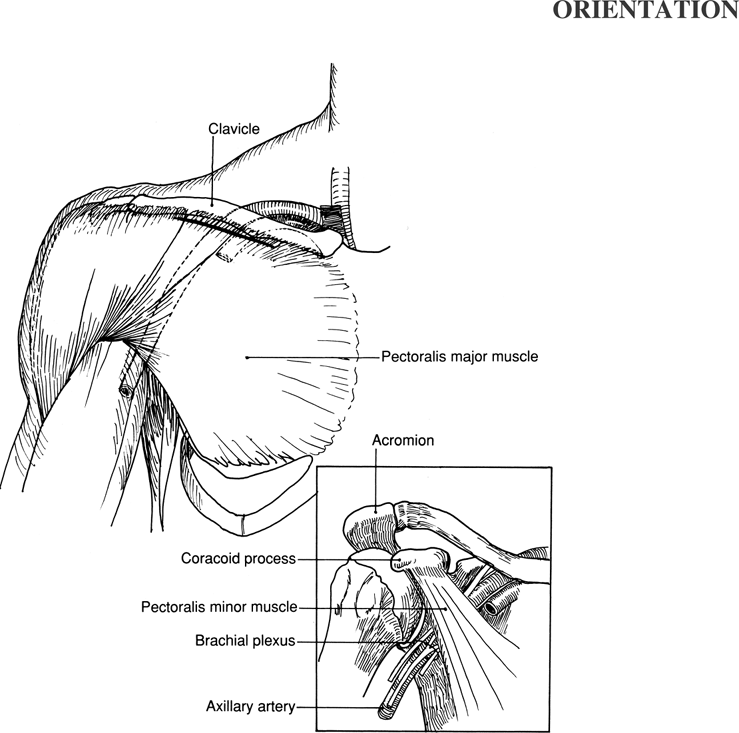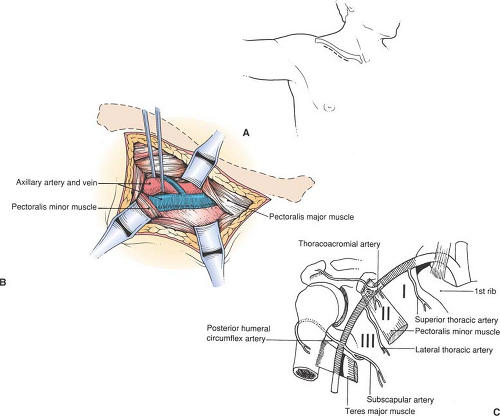Axillobifemoral Bypass
Kenneth B. Simon
Axillobifemoral bypass is one of the most commonly performed extraanatomic bypasses in vascular surgery today. This procedure is generally performed in the following types of patients:
Patients who have undergone previous multiple intraabdominal procedures
Poor-risk patients with impending limb loss who are not candidates for aortic reconstruction by the transabdominal or retroperitoneal approach
Patients with intraabdominal sepsis
Patients with infected aortic grafts that must be removed
The vascular conduit created by this procedure provides adequate inflow to the lower extremities.
In this chapter, the procedures of axillofemoral and axillobifemoral bypass (the more common of the two) are illustrated and used to introduce the anatomy of the axillary artery. By necessity, some anatomy of the femoral region is included as well; this topic is presented in greater detail in Chapters 94 and 108.
Steps in Procedure
Supine position, small roll under ipsilateral flank
Prep entire chest, abdomen, both groins
10 cm transverse incision inferior margin of clavicle
Incise pectoral fascia and muscle in direction of fibers
Expose axillary artery and vein in subpectoral space
Isolate axillary artery and surround with vessel loops
Ligate and divide highest thoracic artery (if necessary)
Longitudinal incision overlying femoral vessels
Expose and obtain control of common femoral, profunda femoris, and superficial femoral artery
Create subcutaneous tunnel from axilla to groin
Fully heparinize the patient
Perform axillary anastomosis first
Obtain proximal and distal control of axillary artery
2 cm arteriotomy on inferior surface of axillary artery
Beveled anastomosis of graft to artery with running 5-0 polypropylene suture
Release distal artery, allowing backflow into graft
Release proximal artery and clamp graft
Pass graft through tunnel with care to avoid torsion
Femoral anastomosis
Control femoral artery
2 cm longitudinal arteriotomy on common femoral artery, extending onto deep femoral artery
Create anastomosis
Flush graft through anastomosis before releasing femoral clamps
Release distal clamp first
Release proximal clamp last
Achieve hemostasis and close wounds in layers
To create axillobifemoral bypass:
Proceed as noted above
Partially occlude distal portion of graft with Satinsky clamp
Create arteriotomy 1.5 to 2 cm long on anteromedial surface of graft
Tailor an 8 mm graft and anastomosis it to the axillofemoral graft
Tunnel through suprapubic subcutaneous tissue
Create anastomosis to femoral artery as noted above
List of Structures
Axillary Region
Thyrocervical trunk
Suprascapular artery
Transverse cervical artery
Axillary artery
Highest (superior) thoracic artery
Thoracoacromial artery
Pectoral branch
Acromial branch
Clavicular branch
Deltoid branch
Lateral thoracic artery
Subscapular artery
First anterior intercostal artery
Clavicle
Scapula
Coracoid process
Deltopectoral groove
Pectoralis major
Pectoralis minor
Pectoral fascia
Deltoid muscle
Subclavius muscle
Clavipectoral fascia
Sternoclavicular joint
Axillary vein
Cephalic vein
Brachial plexus
Supraclavicular nerves (medial, intermediate, and lateral)
Sternocleidomastoid muscle
Platysma muscle
Femoral Region
Anterosuperior iliac spine
Inguinal ligament
Fossa ovalis (saphenous hiatus)
Femoral vein
Superficial circumflex iliac vein
Superficial epigastric vein
Greater saphenous vein
Inguinal lymph nodes (superficial and deep)
Femoral artery
Superficial femoral artery
Profunda femoris artery
 |
Position of the Patient and Exposure of the Axillary Artery (Fig. 34.1)




